 W
WCitrus taxonomy refers to the botanical classification of the species, varieties, cultivars, and graft hybrids within the genus Citrus and related genera, found in cultivation and in the wild.
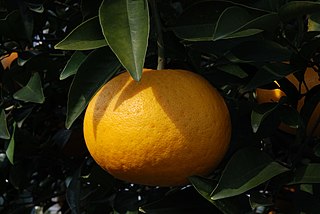 W
WAmanatsu (甘夏) or natsumikan is a yellowish orange citrus hybrid fruit, a group of cultivars of Citrus natsudaidai, which were discovered in 1740 in the Yamaguchi prefecture of Japan.
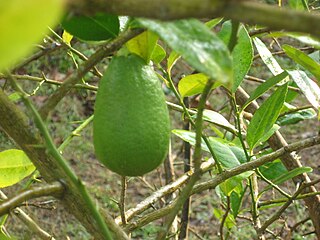 W
WAssam Lemon, also known as Nemu Tenga in Assamese, are cultivars of lemon, namely 'Gol Nemu' and 'Kaji Nemu', which are found and cultivated in the Indian state of Assam. These lemons are an important part of Assamese cuisine. The botanical name of Assam Lemon is Citrus limon.
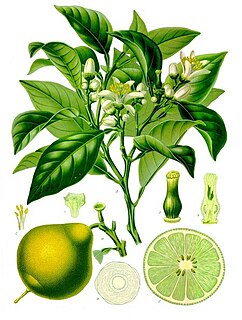 W
WCitrus bergamia, the bergamot orange, is a fragrant citrus fruit the size of an orange, with a yellow or green color similar to a lime, depending on ripeness.
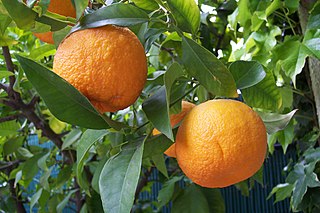 W
WBitter orange, Seville orange, sour orange, bigarade orange, or marmalade orange is the citrus tree Citrus × aurantium and its fruit. It is native to Southeast Asia and has been spread by humans to many parts of the world. It is probably a cross between the pomelo, Citrus maxima, and the mandarin orange, Citrus reticulata.
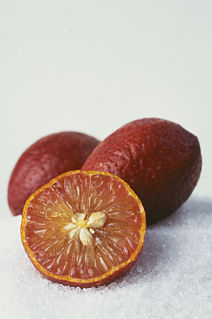 W
WBlood limes are a hybrid citrus fruit developed by the CSIRO project to investigate salt-resistant crops.
 W
WThe blood orange is a variety of orange with crimson, almost blood-colored flesh.
 W
WCalamansi, also known as calamondin, Philippine lime, or Philippine lemon, is an economically important citrus hybrid predominantly cultivated in the Philippines. It is native to the Philippines, Borneo and Sulawesi in Southeast Asia, as well as southern China and Taiwan in East Asia. Calamansi is ubiquitous in traditional Filipino cuisine. It is used in various condiments, beverages, dishes, marinades, and preserves. Calamansi is also used as an ingredient in Malaysian and Indonesian cuisines.
 W
WThe cam sành or King orange is a citrus hybrid originating in Vietnam.
 W
WThe citrange is a citrus hybrid of the sweet orange and the trifoliate orange.
 W
WCitrofortunella are a large group of commercial hybrids that cross the kumquat with other citrus. In the system of citrus taxonomy established by Swingle, kumquats were placed in a different genus, Fortunella, from Citrus, which included citron, mandarin orange, pomelo and papedas. The result of genetic crosses between kumquats and these other citrus would then be intergeneric hybrids, so a novel genus name was coined for them in 1975, by making a portmanteau of the names of the contributing genera to form Citrofortunella. That the genus is of a hybrid nature is represented by a multiplication sign before the genus name, for example × Citrofortunella microcarpa. Recent phylogenetic work has shown kumquats to fall within Citrus rather than belonging to a distinct genus, meaning these would no longer be considered intergeneric hybrids, and use of Citrofortunella as a distinct genus name for these hybrids loses taxonomic validity. They would instead fall within Citrus.
 W
WCalamansi, also known as calamondin, Philippine lime, or Philippine lemon, is an economically important citrus hybrid predominantly cultivated in the Philippines. It is native to the Philippines, Borneo and Sulawesi in Southeast Asia, as well as southern China and Taiwan in East Asia. Calamansi is ubiquitous in traditional Filipino cuisine. It is used in various condiments, beverages, dishes, marinades, and preserves. Calamansi is also used as an ingredient in Malaysian and Indonesian cuisines.
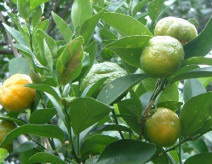 W
WCitrus depressa, in English sometimes called shiikuwasha, shequasar, Taiwan tangerine, Okinawa lime, flat lemon, hirami lemon, or thin-skinned flat lemon, is a small, green citrus fruit rich in flavonoids and native to East Asia.
 W
WBitter orange, Seville orange, sour orange, bigarade orange, or marmalade orange is the citrus tree Citrus × aurantium and its fruit. It is native to Southeast Asia and has been spread by humans to many parts of the world. It is probably a cross between the pomelo, Citrus maxima, and the mandarin orange, Citrus reticulata.
 W
WCitrus bergamia, the bergamot orange, is a fragrant citrus fruit the size of an orange, with a yellow or green color similar to a lime, depending on ripeness.
 W
WA clementine is a tangor, a citrus fruit hybrid between a willowleaf mandarin orange and a sweet orange, named for its late 19th-century discoverer. The exterior is a deep orange colour with a smooth, glossy appearance. Clementines can be separated into 7 to 14 segments. Similar to tangerines, they tend to be easy to peel. They are typically juicy and sweet, with less acid than oranges. Their oils, like other citrus fruits, contain mostly limonene as well as myrcene, linalool, α-pinene and many complex aromatics.
 W
WThe lemon, Citrus limon, is a species of small evergreen tree in the flowering plant family Rutaceae, native to South Asia, primarily North eastern India.
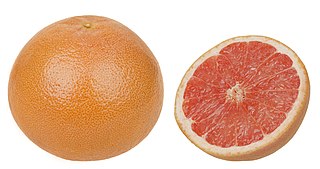 W
WThe grapefruit is a subtropical citrus tree known for its relatively large sour to semisweet, somewhat bitter fruit. Grapefruit is a citrus hybrid originating in Barbados as an accidental cross between the sweet orange and the pomelo or shaddock, both of which were introduced from Asia in the 17th century. When found, it was called the forbidden fruit. In the past it was referred to as the pomelo, but that term is now the common name for the pomelo, which is also called the pummelo.
 W
WCitrus × sinensis, also known as the Citrus sinensis, includes the commonly cultivated sweet oranges, including blood oranges and navel oranges.
 W
WThe tangelo, Citrus × tangelo, is a citrus fruit hybrid of a Citrus reticulata variety such as mandarin orange or a tangerine, and Citrus maxima variety, such as a pomelo or grapefruit. The name is a portmanteau of 'tangerine' and 'pomelo'.
 W
WCitrus × deliciosa is a citrus hybrid mandarin orange with just under 6 % pumelo ancestry. It is related to the ponkan.
 W
WA clementine is a tangor, a citrus fruit hybrid between a willowleaf mandarin orange and a sweet orange, named for its late 19th-century discoverer. The exterior is a deep orange colour with a smooth, glossy appearance. Clementines can be separated into 7 to 14 segments. Similar to tangerines, they tend to be easy to peel. They are typically juicy and sweet, with less acid than oranges. Their oils, like other citrus fruits, contain mostly limonene as well as myrcene, linalool, α-pinene and many complex aromatics.
 W
WDekopon (デコポン) is a seedless and sweet variety of mandarin orange.
 W
WThe Florentine citron – citron hybrid of Florence – is a very fragrant citrus fruit, which is named after its most known origin of cultivation. Its scientific name is Citrus ×limonimedica 'Florentina' Lush.
 W
WThe Friendship Tree is a unique citrus tree, in the Friendship Tree Garden Museum and Subtropical Botanical Garden, in the Tsentralny City District of Sochi, on the east coast of the Black Sea in southern Russia.
 W
WThe grapefruit is a subtropical citrus tree known for its relatively large sour to semisweet, somewhat bitter fruit. Grapefruit is a citrus hybrid originating in Barbados as an accidental cross between the sweet orange and the pomelo or shaddock, both of which were introduced from Asia in the 17th century. When found, it was called the forbidden fruit. In the past it was referred to as the pomelo, but that term is now the common name for the pomelo, which is also called the pummelo.
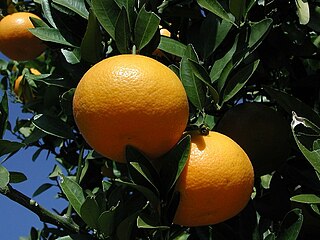 W
WThe iyokan, also known as anadomikan (穴門みかん) and Gokaku no Iyokan, is a Japanese citrus fruit, similar in appearance to a mandarin orange, arising from a cross between the Dancy tangerine and another mandarin variety, the kaikoukan. It is the second most widely produced citrus fruit in Japan after the satsuma mandarin.
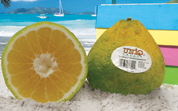 W
WThe Jamaican tangelo, also known by proprietary names ugli fruit, uglifruit, and uniq fruit, is a citrus fruit that arose on the island of Jamaica through the natural hybridization of a tangerine or orange with a grapefruit, and is thus a tangelo. The original tree is believed to have been a hybrid formed from the Seville orange, the grapefruit and the tangerine families.
 W
WThe Kabbad refers to a citron-like fruit or citrus hybrid which was first described in 1963 by the Moroccan professor Henri Chapot, in his article named "Le Cédrat Kabbad et deux autres variétés de cédrat", who remarked it to be a biological hybrid between the citron and the orange sourcing from Damaskus, Syria.
 W
WKabosu is a citrus fruit of an evergreen broad-leaf tree in the family Rutaceae. It is popular in Japan, where its juice is used to improve the taste of many dishes, especially cooked fish, sashimi, and hot pot dishes.
 W
WThe Key lime is a citrus hybrid with a spherical fruit, 25–50 mm (1–2 in) in diameter. The Key lime is usually picked while it is still green, but it becomes yellow when ripe.
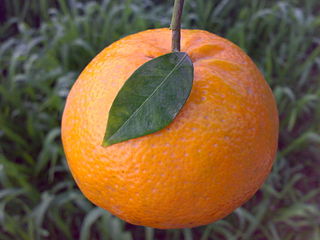 W
WThe 'Kinnow' is a high yield mandarin hybrid cultivated extensively in the wider Punjab region of India and Pakistan.
 W
WKiyomi is a Japanese citrus fruit that is a hybrid of a Miyagawa Wase mikan and an orange. The new breed was the first tangor created in Japan in 1949. It was named Kiyomi after the temple Seiken-ji (清見寺) and the lagoon Kiyomi-gata (清見潟) near its experiment station in Shizuoka city and registered as "Tangor Nōrin No.1" in 1979.
 W
WThe lemon, Citrus limon, is a species of small evergreen tree in the flowering plant family Rutaceae, native to South Asia, primarily North eastern India.
 W
WLemonade fruit is a citrus fruit that is a hybrid between a mandarin orange and a lemon, grown in Australia and New Zealand.
 W
WA lime, known as dayap in the Philippines, is a citrus fruit, which is typically round, green in color, 3–6 centimetres (1.2–2.4 in) in diameter, and contains acidic juice vesicles.
 W
WThe lumia is also called the pear lemon, since its shape resembles a pear. It is also called French lime and sometimes sweet lemon, even though it is not necessarily sweet.
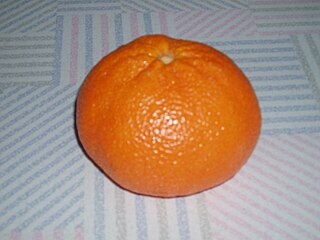 W
WA mandora is a cross of mandarin and orange, grown on Cyprus.
 W
WThe Melogold or Melogold grapefruit is a citrus hybrid similar to the oroblanco; both result from a cross between the pomelo and the grapefruit and is a fruit similar to a sweet grapefruit.
 W
WCitrus × meyeri, the Meyer lemon, is a hybrid citrus fruit native to China. It is a cross between a citron and a mandarin/pomelo hybrid distinct from the common or bitter lemon.
 W
WThe Murcott is a tangor, or mandarin–sweet orange hybrid.
 W
WThe New Zealand grapefruit, otherwise known as the Poorman's orange or Goldfruit is a type of citrus fruit grown in New Zealand. Despite its name it's not botanically a true grapefruit, believed to be a hybrid between a pomelo and either a mandarin or tangelo.
 W
WThe Nippon orangequat is a cross between a Satsuma mandarin and a Meiwa kumquat, hybridized by Dr. Eugene May of the USDA and introduced in 1932, and is a member of the citrofortunella group. 'Nippon' is the only named cultivar in existence.
 W
WAn oroblanco, oro blanco or sweetie is a sweet seedless citrus hybrid fruit similar to grapefruit. It is often referred to as oroblanco grapefruit.
 W
WPersian lime, also known by other common names such as seedless lime, Bearss lime and Tahiti lime, is a citrus fruit species of hybrid origin, known only in cultivation. The Persian lime is a triploid cross between key lime and lemon.
 W
WThe ponderosa lemon is a citrus hybrid of a pomelo and a citron. It is not the same as the 'Yuma Ponderosa' lemon pomello hybrid, that is used as citrus rootstock.
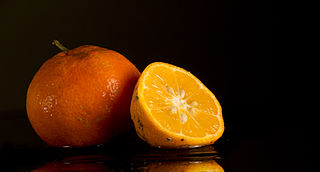 W
WRangpur, Citrus × limonia or Citrus reticulata × medica, sometimes called the rangpur lime, mandarin lime or lemandarin, is a hybrid between the mandarin orange and the citron. It is a citrus fruit with a very acidic taste and an orange peel and flesh.
 W
WReikou is a cultivar of tangor. It is a citrus hybrid of a hybrid of Kiyomi and Encore and Murcott tangor.
 W
WRhobs al-Arsa is a very popular citrus fruit in Morocco.
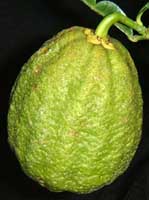 W
WThe shangjuan, or Ichang lemon, is a cold-hardy citrus fruit and plant originating in East Asia.
 W
WShonan Gold (湘南ゴールド) is a hybrid Japanese citrus, with a characteristic "golden" bright yellow color.
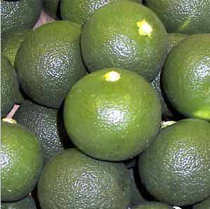 W
WSudachi is a small, round, green citrus fruit of Japanese origin that is a specialty of Tokushima Prefecture in Japan. It is a sour citrus, not eaten as fruit, but used as food flavoring in place of lemon or lime. Genetic analysis shows it to be the product of a cross between a yuzu and another citrus akin to the koji and tachibana orange.
 W
WThe tangelo, Citrus × tangelo, is a citrus fruit hybrid of a Citrus reticulata variety such as mandarin orange or a tangerine, and Citrus maxima variety, such as a pomelo or grapefruit. The name is a portmanteau of 'tangerine' and 'pomelo'.
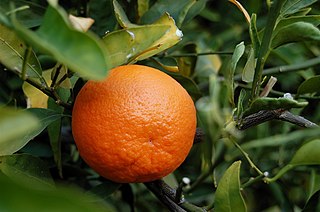 W
WThe tangerine is a group of orange-coloured citrus fruit consisting of hybrids of mandarin orange.
 W
WThe tangor is a citrus fruit hybrid of the mandarin orange and the sweet orange. The name "tangor" is a formation from the "tang" of tangerine and the "or" of "orange". Also called the temple orange, its thick rind is easy to peel and its bright orange pulp is sour-sweet and full-flavoured.
 W
WThe Yukou is a Japanese citrus found in the Nagasaki Prefecture and Saga Prefecture of Japan. Genetic analysis has shown it to be a cross between the kishumikan and koji, a part-tachibana orange hybrid native to Japan.